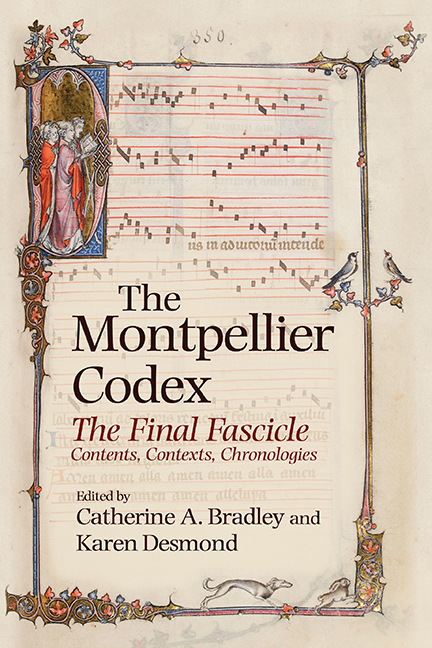Book contents
- Frontmatter
- Contents
- Figures
- Musical examples
- Tables
- Acknowledgements
- List of manuscript sigla
- Abbreviations
- Table of fascicle 8 contents
- Introduction
- I The Material Object
- 1 Montpellier 8: Anatomy of …
- 2 A Palaeographical Analysis of the Verbal Text in Montpellier 8: Problems, Implications, Opportunities
- 3 The Style and Iconography of Montpellier folio 35or
- 4 The Decoration of Montpellier 8: Its Place in the Continuum of Parisian Manuscript Illumination
- 5 Double Motet Layouts in the Montpellier Codex and Contemporaneous Libri motetorum
- 6 Deus in adiutorium Revisited: Sources and Contexts
- 7 Thematic Clusters and Compilational Strategies in Montpellier 8
- II INNOVATION AND TRADITION
- III ANALYTICAL CASE STUDIES
- Bibliography
- Contributors
- General index
- Index of compositions, alphabetical
- Index of compositions in Mo, manuscript order
- Miscellaneous Endmatter
5 - Double Motet Layouts in the Montpellier Codex and Contemporaneous Libri motetorum
from I - The Material Object
Published online by Cambridge University Press: 04 July 2019
- Frontmatter
- Contents
- Figures
- Musical examples
- Tables
- Acknowledgements
- List of manuscript sigla
- Abbreviations
- Table of fascicle 8 contents
- Introduction
- I The Material Object
- 1 Montpellier 8: Anatomy of …
- 2 A Palaeographical Analysis of the Verbal Text in Montpellier 8: Problems, Implications, Opportunities
- 3 The Style and Iconography of Montpellier folio 35or
- 4 The Decoration of Montpellier 8: Its Place in the Continuum of Parisian Manuscript Illumination
- 5 Double Motet Layouts in the Montpellier Codex and Contemporaneous Libri motetorum
- 6 Deus in adiutorium Revisited: Sources and Contexts
- 7 Thematic Clusters and Compilational Strategies in Montpellier 8
- II INNOVATION AND TRADITION
- III ANALYTICAL CASE STUDIES
- Bibliography
- Contributors
- General index
- Index of compositions, alphabetical
- Index of compositions in Mo, manuscript order
- Miscellaneous Endmatter
Summary
HISTORIES of layouts of polyphonic music describe parts in succession in the earliest sources, followed by pseudo-score layout (for example in the so-called monotextual or conductus motet), then an arrangement of the parts in ‘reading windows’ (Lesefenstern; either placing the upper voices of a double motet in two columns on one page or one voice per page of an opening and the tenor on the lowermost stave), and finally by the so-called choir-book layout, which presents the upper parts on facing pages of an opening with the tenor no longer at the bottom of the page but following on directly from either the motetus or the triplum. This becomes the standard layout, and the change of the position of the tenor points to a change in the conceptualization of the tenor part.
These different layouts do not succeed each other in chronological order. There is neither a particular ‘Notre-Dame layout’ nor an ‘Ars antiqua layout’ nor yet an ‘Ars nova layout’ of three-part motets. The consecutive presentation of voices is found from the very beginning of the transmission of motets until the late fourteenth century. And the presentation of the upper parts in two columns with the tenor on a continuous stave at the bottom, which emerges with the liber motetorum, is still found in manuscripts of the second half of the fourteenth century. The only correlation between repertoire layers and distinct layouts is found for the more particular layouts of Mo 7 and 8, to be discussed here.
LAYOUTS IN MO 8
Twenty-one out of the forty-two motets in the final fascicle of Mo are laid out, as in many other thirteenth-century manuscripts, with the upper parts in columns and a continuous stave for the tenor at the bottom (Figure 5.1a); this will be defined here as the standard-column layout. The other twenty-one motets employ a layout not found in any thirteenth-century manuscript (hereafter ‘Mo 8 layout’). This characteristic Mo 8 layout places the end of the triplum on one or more continuous staves below both columns, followed by the tenor on the lowermost stave (Figure 5.1b). The ruling of the pages is the same as for the standard- column layout; only later were the staves of the columns connected.
- Type
- Chapter
- Information
- The Montpellier CodexThe Final Fascicle. Contents, Contexts, Chronologies, pp. 90 - 99Publisher: Boydell & BrewerPrint publication year: 2018

